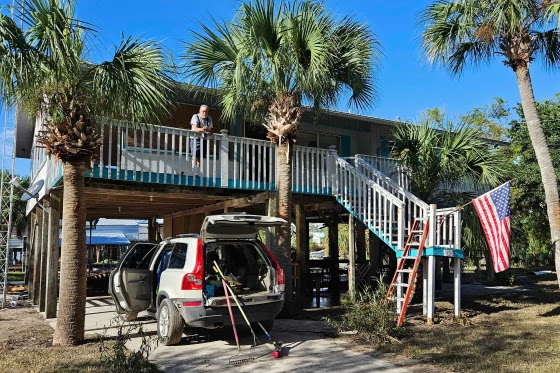Why Some Homes Along Florida's Coast Survived Hurricane Idalia's Wrath?
HORSESHOE BEACH, Fla. —
In the aftermath of Hurricane Idalia's devastating rampage through the isolated fishing village of Horseshoe Beach, a striking contrast emerged. While many modest homes along the Big Bend coast lay in ruins, interspersed among the debris were residences that remained surprisingly intact. The key to their survival? Elevated structures built on sturdy stilts.
Sparky Abrandt, a 78-year-old resident of Horseshoe Beach, stood on the porch of his teal-trimmed house, which stood 13 feet above the ground, relatively unscathed amidst the destruction. "This home is a survivor," he remarked, surveying the wreckage around him. He acknowledged the role of fate in his house's preservation, saying, "To me, it's luck my house is here." Abrandt, a former New Yorker who had relocated to the area five years prior, added, "Right now, I'm happy that the house was saved."
Yet, according to state officials and home building experts, it's not merely luck but rather the result of regularly updated state building codes that allowed certain homeowners to escape total devastation. As catastrophic weather events, increasingly linked to rising global temperatures, underscore the urgency of adapting to climate change, a complex balance must be struck between reinforcing structures and considering income disparities while preserving local culture.
Craig Fugate, the former Federal Emergency Management Agency administrator during the Obama administration, elaborated on the dilemma: "You'll have people who argue, 'If you make new codes, I can't afford to upgrade, and I can't afford to live here, so just let me put it back the way it was.'" He continued, "But then maybe you'll have developers coming in, willing to buy distressed properties… This will be a debate."
This debate could emerge in various vulnerable areas, such as the Hawaiian island of Maui, recently struck by deadly wildfires, and Horseshoe Beach, often referred to as "Florida's Last Frontier," with its population of roughly 170 people.
Hurricane Idalia, which made landfall about 30 miles north of Horseshoe Beach with maximum sustained winds of 125 mph, wreaked havoc across the Gulf Coast region. In Florida alone, at least three lives were tragically lost, while the hurricane's impacts extended into Georgia and other East Coast states before dissipating into a post-tropical cyclone.
As the cleanup effort continues, builders in Florida have emphasized the significance of the fact that not all homes were wiped out, even in areas as hard-hit as Horseshoe Beach.
Don Brown, a member of the Florida Building Commission and a former legislator from the Panhandle, stated, "No question that the codes work… They provide both life safety and reduce destruction of property. Having said that, there's lways room for improvement."
Florida's building codes were strengthened in the aftermath of Hurricane Andrew's devastation in 1992, transitioning from a patchwork of local rules to a unified standard. These codes are revised every three years, with the eighth edition set to take effect at the end of the year.
According to Mike Silvers, director of technical services at the Florida Roofing and Sheet Metal Contractors Association, knowledge gained from each hurricane can inform subsequent changes to the building codes. Hurricane Idalia may offer its own insights into reinforcing these rules. Silvers explained, "The code in Florida is pretty stringent… You don't have to immediately go back and do things because the law changed, but there are triggers within the law that do create things that should be done."
After Hurricane Michael struck the Florida Panhandle in 2018 as a Category 5 storm, Silvers observed that even older homes fared better if they had been retrofitted with additional layers to protect against water.
The aftermath of Hurricane Idalia also highlighted the effectiveness of elevating homes on pilings to protect against storm surges. Silvers noted, "Even from the aerial shots, you can see if you look at a particular road or along a canal, you might see homes that have been beat up and others that have survived very well… So when you pull the building permits to see why, seldom are we surprised that it's the newer ones built to higher standards that are standing out from the others."
However, elevating an existing home can entail costs in the tens of thousands of dollars, posing a significant financial challenge for homeowners with older residences.
Brown pointed out that residents in areas not typically prone to major storms or flooding may become complacent, but hurricanes like Idalia, the strongest to make landfall in the Big Bend region in over 125 years, serve as a stark reminder of the need for preparedness.
For those whose homes were destroyed, grants for rebuilding may be available through FEMA and the federal Department of Housing and Urban Development. However, depending on their location, applicants may face the requirement of adhering to stricter building codes and insurance requirements.
Fugate emphasized the notion of preserving communities like Horseshoe Beach, untouched by strip malls and high-rise developments, as an ideal prospect. While this was achieved after the "storm of the century" struck the Big Bend region in 1993, Idalia may represent a turning point.
"Fulfilling the hope of putting it back the way it was without change is an overly optimistic viewpoint," Fugate stated. "The challenges are real, especially for those who didn't have insurance."
Abrandt, whose home happened to be constructed on stilts when he purchased it, is counting his blessings. Although he lost an area below his home that he had remodeled to include an outdoor bar and a wall-mounted television, he remains steadfast in his appreciation for the simple life that Horseshoe Beach represents.








Commentaires
Enregistrer un commentaire